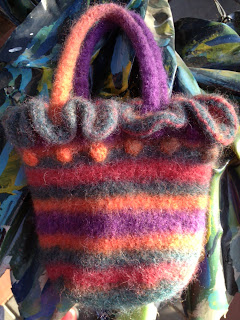 The felted bags are done - and the small ones off to good girly homes.
The felted bags are done - and the small ones off to good girly homes.I devised a clasp for the small ones, consisting of a button attached to a loop of hat elastic stitched inside the top back edge of the bag, and a large button fixture on the outside front of the bag. The elastic loop can be pulled over the button on the outside to hod the bag closed.
The elastic slots between the frills when in use an barely notices on the stripy bags.
On the apricot bag the elastic notices a little, but is, I think OK.
When not in use the loop hangs inside the bag.

 This is the large bag with the handles realigned and embellished with ceramic buttons at each end. I cut each handle from the bag at one end and stitched it back on. The felting is sufficient to prevent unravelling. You can see a slight raise in the top edge where the handle used to be.
This is the large bag with the handles realigned and embellished with ceramic buttons at each end. I cut each handle from the bag at one end and stitched it back on. The felting is sufficient to prevent unravelling. You can see a slight raise in the top edge where the handle used to be.
The buttons are decorative rather than utilitarian, but the bag is now both attractive and fully functional!












































